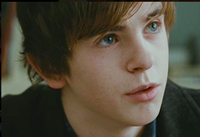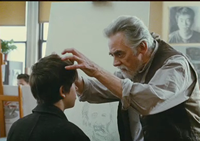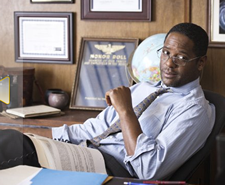The Art of Getting By
(Originally published on blogcritics.org)
About two thirds through this film I began to recall The Graduate, the 1967 Dustin Hoffman classic, which was a key artistic moment for my generation. I believe that The Art of Getting By, a Fox Searchlight film which opens in limited release Friday, June 17, 2011, can be of equal significance for this generation and to the careers of young actor Freddie Highmore (Charlie and The Chocolate Factory, Finding Neverland, August Rush) and writer/director Gavin Wiesen.
Highmore plays George, a senior at an expensive, private high school in New York, in possession of enough angst and depression to make a roomful of beatniks look like a multi-level marketing pep-rally. His biggest problem with life is that it ends. What good is trying, if you’re just going to die eventually?
George lives out his dark world view by just getting by. As the story begins, he has managed to make it almost all the way through high school without actually doing any work. Even in art class, the one subject that interests him, he doodles instead of completing the assignments.
Highmore plays what could have been a totally unsympathetic character with a charm and vulnerability that makes it impossible not to root for him. George’s self-pitying life takes an unexpected turn when he takes the blame for one of the school’s prettiest and most popular girls, Sally, when she is about to be caught smoking on the roof.
Sally, played by Emma Roberts (Scream 4, Valentine’s Day, Nancy Drew), whisks George into her life of hip parties. As they skip school together to go to galleries and museums, they become best friends. George begins to fall for the flirtatious Sally, but is clueless about how to let her know.
A second wild card comes into George’s hand when he meets a school alumnus on career day, Dustin, played by Michael Angarano (One Last Thing, The Forbidden Kingdom). Dustin is making it in the trendy New York art scene. He mentors George about careers and girls and serves as an inspirational, if often inebriated, role model.
George begins to envision himself as an artist with Sally as his muse, and then things start to go wrong. He discovers it’s hard to deal with this new reality, when your life has been based on just getting by.
The Art of Getting By is the first feature film for writer/director Gavin Wiesen. It is a remarkable film on many levels, including story, acting, and cinematography. Not only do the main characters – George, Sally and Dustin – feel real, but so do nearly all the supporting characters. Writers are told to give all their characters personality, but sometimes try to do this with an eye-patch or a Southern accent. In this case, however, with remarkably efficient use of dialog and action we meet a group of supporting characters who possess almost the same depth as the leads.
We meet George’s mom, Vivian, played by Rita Wilson (It’s Complicated), a New York business woman who struggles, unsuccessfully, to understand her son, while trying to protect him from the problems she is having with his step-father.
Sally’s mother, Charlotte, played by Elizabeth Reaser (the Twilight series), is a mirror image of George’s mom, having turned her teenage daughter into her best friend and being almost totally focused on her own future, rather than her daughter’s.
At George’s school, he is both championed and prodded by dedicated educators. His principal, played by Blair Underwood (Full Frontal, Rules Of Engagement, Gattaca), uses a carrot and stick approach to keep George moving. His art instructor, played by Broadway staple Jarlath Conroy (True Grit, Kinsey, Heaven’s Gate) sees George’s real talent and gives him an artistic challenge that leads to one of the climatic moments of the film. They both confront him about his lack of initiative and its consequences.
Underwood and Conroy take what could have been cliché “dedicated teacher” roles and bring to them to life in totally convincing ways.
Another important character in the film was New York. Director Wiesen brought his own experiences growing up in New York City to the film, illustrating how New York’s melting-pot milieu trickles down to high school, providing good and bad distractions. The city’s energy permeates everything and capturing that was the job of Director of Photography Ben Kutchins.
Kutchins got the job because of his experience in the New York indie world. “When I’m not shooting, I’m wandering around the city looking for things that I haven’t seen in movies,” he said.. “Everyone knows what the Empire State Building looks like and what Times Square look like, but I’m always looking for that obscure corner that gives you a new feeling. Gavin and I shared a lot of secret locations that we had been storing away over the years.” Seinfeld fans will recognize “the restaurant”.
As the ending of the film approached, I feared that like many recent films, it would leave us hanging. I believe that G.K. Chesterson’s famous quip, “The purpose of an open mind is like that of an open mouth, which is to close it down on something solid,” also applies to film. I was not disappointed, and the ending again reminded me of The Graduate.
I believe in writing balanced reviews. I saw this film with my daughter, who was born more than a decade after The Graduate premiered, so I had a youthful perspective to add to my old-guy ranting. Both of us tried to find something wrong with this film that I could include in this review. Neither of us could. It’s close to perfect. I’m looking forward to seeing more work by writer/director Gavin Wiesen.






